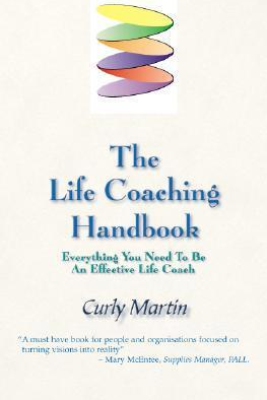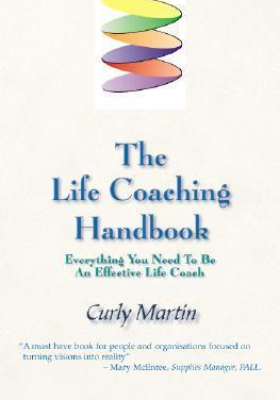“The Life Coaching Handbook” by Curly Martin is an essential guide for aspiring and professional life coaches, offering a practical and philosophical roadmap to mastering the art of coaching. With its holistic approach, the book delves into the principles, techniques, and frameworks necessary to empower clients to unlock their potential. This review explores the key themes and lessons presented in the book, emphasizing its transformative insights for personal growth, professional development, and effective coaching.
Martin’s approach combines foundational coaching principles with advanced methodologies like Neuro-Linguistic Programming (NLP) and the Spiral Coaching Model. Whether you are considering life coaching as a career, seeking to refine your skills, or looking for personal development tools, this book delivers a wealth of wisdom.
15 Transformative lessons from the book are:
Lesson 1: Life Coaching is About Results, Not Therapy
Martin emphasizes that life coaching focuses on the present and future, unlike therapy, which often delves into the past. The primary goal of coaching is to help clients identify their objectives and achieve measurable results.
Example: Instead of exploring the causes of past failures, a life coach guides the client in setting actionable goals for immediate progress.
Lesson 2: The Power of Commitment Drives Success
A central theme in Martin’s philosophy is the power of commitment. She explains that when clients commit to a goal, they are more likely to follow through due to the social and psychological pressure to stay true to their word.
Practical Tip: Use accountability measures, such as setting deadlines or involving others, to reinforce commitment.
Lesson 3: Self-Belief Shapes Reality
Martin explores how beliefs are formed and their impact on behavior. She provides actionable steps to help clients identify and replace limiting beliefs with empowering ones.
Exercise: Encourage clients to write down a limiting belief, find evidence that contradicts it, and replace it with a positive affirmation.
Lesson 4: Effective Communication is Key
Communication goes beyond words; it involves body language, tone, and listening skills. Martin highlights the importance of congruency—aligning verbal and nonverbal messages—to build trust and rapport.
Quote: “How you say something matters just as much as what you say.”
Lesson 5: Balance is Essential for Holistic Growth
Life coaching is holistic, addressing all aspects of a client’s life, including career, health, relationships, and personal fulfillment. Martin warns against focusing on one area to the detriment of others.
Example: A client achieving business success at the cost of their health is a red flag for a life coach to address.
Lesson 6: Coaching is Not Advising
One of the foundational principles Martin outlines is that coaches do not give advice. Instead, they empower clients to find their own solutions through effective questioning.
Key Insight: “The best answers come from within the client.”
Lesson 7: The Role of NLP in Coaching
Martin integrates Neuro-Linguistic Programming techniques to enhance coaching effectiveness. These include state control, representational systems, and the use of metaphors to unlock client potential.
Application: Use the Milton Model to frame suggestions in a way that resonates deeply with clients.
Lesson 8: Overcoming Limiting Beliefs
Martin provides a step-by-step process for helping clients overcome limiting beliefs that hinder progress. This includes identifying the belief, understanding its origin, and consciously replacing it.
Exercise: Use the “self-talk interrupt” method to stop negative thoughts and replace them with empowering affirmations.
Lesson 9: Coaching Requires Active Listening
Listening is more than hearing words; it’s about understanding unspoken messages. Martin advises coaches to use active listening techniques, such as paraphrasing and summarizing, to build deeper connections with clients.
Lesson 10: Building Rapport is Crucial
Rapport is the foundation of a successful coaching relationship. Martin explains how to use mirroring, matching, and pacing techniques to establish trust and alignment with clients.
Practical Tip: Pay attention to a client’s tone and body language to adapt your approach.
Lesson 11: Motivation Comes from Clear Goals
Clients often underperform because they lack clarity in their goals. Martin’s strategies help coaches guide clients in defining specific, measurable, achievable, relevant, and time-bound (SMART) goals.
Lesson 12: Spiral Coaching Unlocks Thinking Patterns
The Spiral Coaching Model, introduced by Martin, helps identify and leverage clients’ thinking patterns. This advanced technique allows coaches to tailor their approach to each client’s unique needs.
Quote: “Understanding how a client thinks is the key to unlocking their potential.”
Lesson 13: Use Metaphors to Inspire Change
Metaphors are a powerful tool in coaching, enabling clients to reframe challenges and see possibilities. Martin provides practical examples of using metaphors to evoke insights.
Example: Comparing life’s obstacles to a road trip helps clients visualize their journey and destination.
Lesson 14: Accountability is Non-Negotiable
Accountability ensures that clients stay on track. Martin suggests creating systems of regular check-ins and progress reviews to maintain momentum.
Actionable Advice: Ask clients to set weekly milestones and share updates.
Lesson 15: Coaching is a Journey of Self-Discovery
Ultimately, life coaching is about helping clients discover who they truly are and what they want from life. Martin’s holistic approach emphasizes self-awareness, growth, and fulfillment.
Quote: “Coaching is about transformation, from caterpillar to butterfly.”
Conclusion: Why The Life Coaching Handbook is a Must-Read
Curly Martin’s The Life Coaching Handbook is an indispensable resource for anyone seeking to understand and excel in life coaching. Its blend of practical advice, NLP techniques, and real-world insights makes it a guide that readers can return to repeatedly. Whether you’re an aspiring coach or someone interested in personal growth, this book offers the tools to transform lives—starting with your own.





